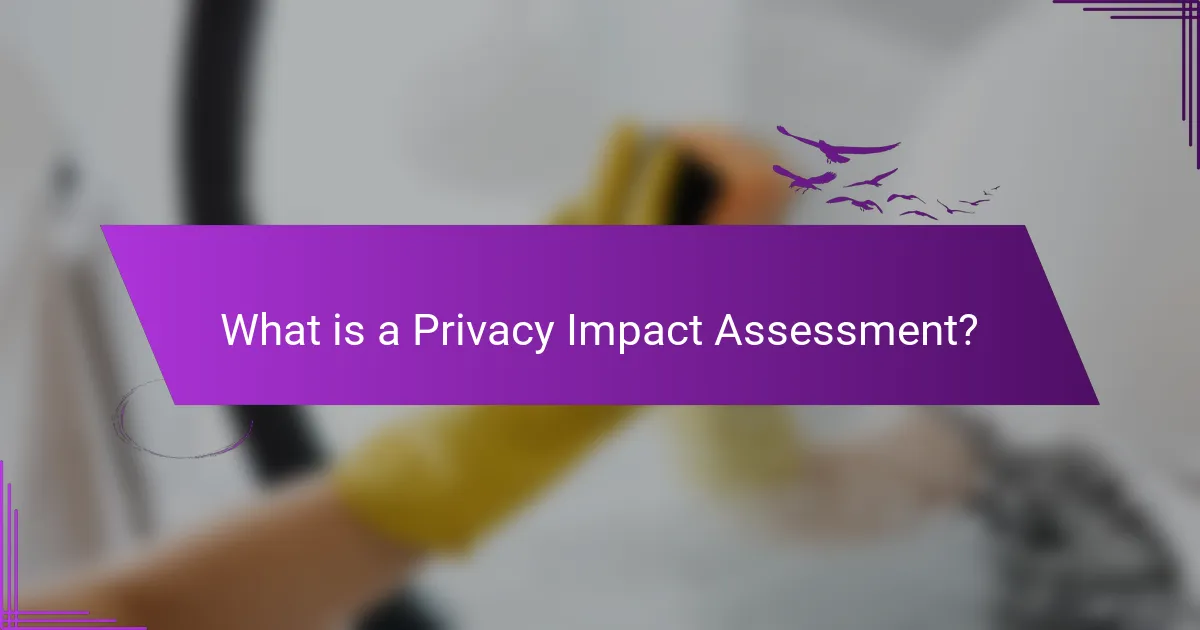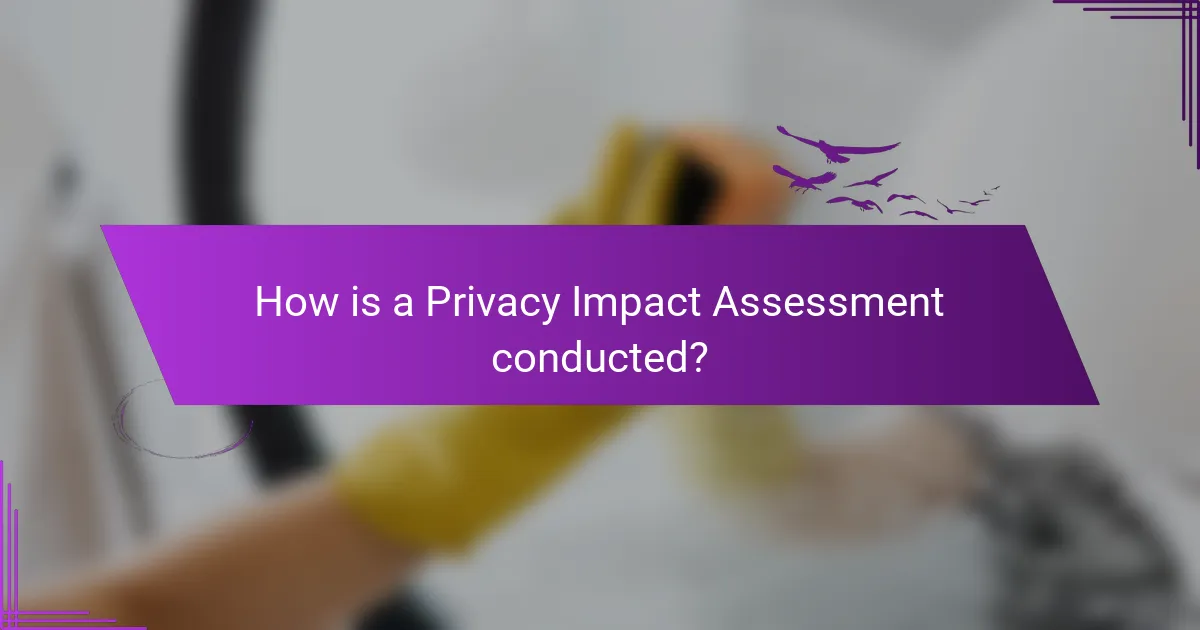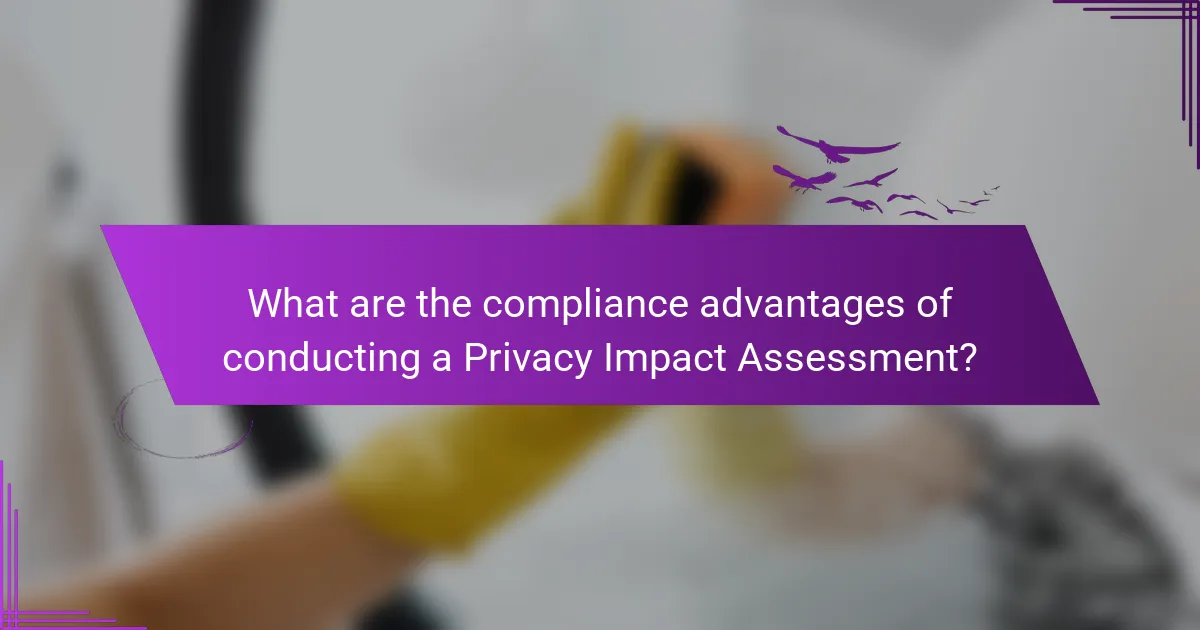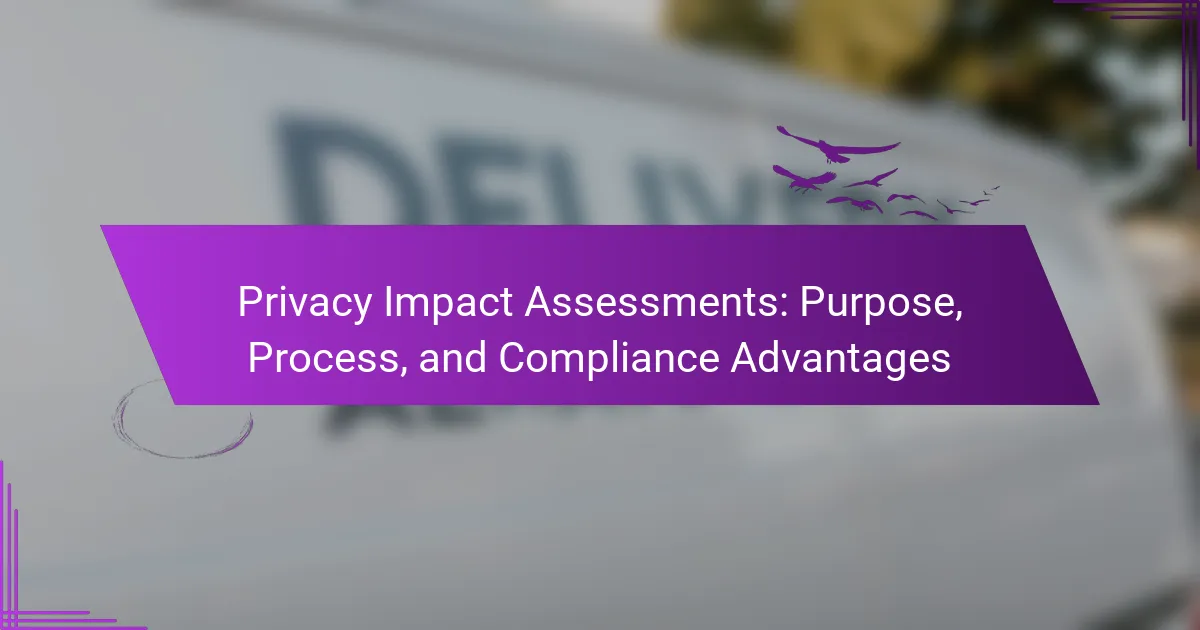
What is a Privacy Impact Assessment?
A Privacy Impact Assessment (PIA) is a process used to evaluate the potential effects of a project or system on the privacy of individuals. It identifies risks and outlines measures to mitigate them. PIAs are essential for ensuring compliance with privacy laws and regulations. They help organizations assess how personal data is collected, stored, and used. Conducting a PIA can enhance transparency and build trust with stakeholders. Furthermore, it can lead to better data management practices. Many jurisdictions mandate PIAs for certain types of projects, particularly those involving sensitive information. This process ultimately supports responsible data handling and privacy protection.
Why are Privacy Impact Assessments important?
Privacy Impact Assessments (PIAs) are important because they help identify and mitigate privacy risks associated with data processing activities. By conducting a PIA, organizations can evaluate how personal data is collected, used, and shared. This proactive approach ensures compliance with privacy laws and regulations, such as the GDPR. Moreover, PIAs foster transparency and trust between organizations and individuals. They also assist in making informed decisions regarding data management practices. Ultimately, PIAs contribute to protecting individuals’ privacy rights and enhancing organizational accountability.
How do Privacy Impact Assessments protect personal data?
Privacy Impact Assessments (PIAs) protect personal data by identifying and mitigating privacy risks. They evaluate how data is collected, used, and shared. PIAs help organizations comply with legal requirements, such as GDPR. They also promote transparency by informing stakeholders about data handling practices. By conducting a PIA, organizations can implement necessary safeguards. This process reduces the likelihood of data breaches and unauthorized access. Studies show that organizations that implement PIAs experience fewer privacy-related incidents. Therefore, PIAs are essential for maintaining trust and protecting individual privacy rights.
What are the legal requirements for conducting a Privacy Impact Assessment?
Legal requirements for conducting a Privacy Impact Assessment (PIA) vary by jurisdiction. Generally, organizations must identify and assess privacy risks associated with personal data processing. They should document the assessment process and outcomes. Compliance with relevant data protection laws, such as GDPR or CCPA, is essential. These laws often mandate conducting a PIA when initiating new projects involving personal data. Organizations must involve stakeholders in the assessment process. They should implement measures to mitigate identified risks. Regular reviews and updates of the PIA are also required to ensure ongoing compliance.
What are the key components of a Privacy Impact Assessment?
The key components of a Privacy Impact Assessment include identifying the project, assessing privacy risks, and evaluating compliance with regulations. The project identification outlines the purpose and scope of the assessment. Assessing privacy risks involves analyzing how personal data will be collected, used, and stored. Evaluating compliance ensures adherence to laws such as GDPR or HIPAA. Additionally, documenting findings and recommendations is crucial for transparency. Engaging stakeholders throughout the process enhances the assessment’s effectiveness. These components collectively help organizations mitigate privacy risks and protect individuals’ data rights.
What steps are involved in conducting a Privacy Impact Assessment?
Identify the need for a Privacy Impact Assessment (PIA). This step involves determining if the project affects personal data. Next, describe the information flow. This includes detailing how personal data is collected, used, and stored. Then, identify and assess privacy risks. This evaluation focuses on potential impacts on individuals’ privacy rights. After that, consult with stakeholders. Engaging stakeholders helps gather insights and concerns regarding privacy issues. Following this, develop mitigation strategies. These strategies aim to address identified risks effectively. Finally, document the PIA process and outcomes. This documentation serves as a record for compliance and future reference.
How do stakeholders contribute to the Privacy Impact Assessment process?
Stakeholders contribute to the Privacy Impact Assessment (PIA) process by providing essential insights and perspectives. Their involvement ensures that various viewpoints are considered, which enhances the assessment’s comprehensiveness. Stakeholders include data subjects, legal experts, and organizational representatives. Each group brings unique knowledge about privacy risks and compliance requirements. For example, data subjects can share their concerns about data handling practices. Legal experts can clarify regulatory obligations, ensuring adherence to laws. Organizational representatives can identify internal processes that may impact privacy. This collaborative approach leads to a more effective PIA, addressing potential privacy issues proactively.

How is a Privacy Impact Assessment conducted?
A Privacy Impact Assessment (PIA) is conducted through a systematic process. First, the organization identifies the project or system that requires assessment. Next, it gathers information about the personal data involved and its purpose. Stakeholders are then consulted to understand potential privacy risks. The organization evaluates these risks against existing safeguards. Recommendations are developed to mitigate identified risks. Finally, the PIA document is reviewed and approved by relevant authorities. This process ensures compliance with privacy laws and regulations.
What methodologies are used in Privacy Impact Assessments?
Privacy Impact Assessments (PIAs) utilize various methodologies to evaluate privacy risks. Common methodologies include risk assessment frameworks, stakeholder consultations, and data flow mapping. Risk assessment frameworks, such as NIST and ISO standards, guide organizations in identifying and mitigating privacy risks. Stakeholder consultations involve engaging with affected parties to gather insights and concerns. Data flow mapping visualizes how personal data is collected, processed, and stored. These methodologies ensure comprehensive analysis and compliance with privacy regulations.
What tools can assist in conducting a Privacy Impact Assessment?
Tools that assist in conducting a Privacy Impact Assessment include software solutions and frameworks. Common tools are PIA templates, risk assessment software, and compliance management platforms. These tools help identify privacy risks and document mitigation strategies. Examples include OneTrust, TrustArc, and Microsoft Compliance Manager. They provide features for data mapping, risk analysis, and stakeholder collaboration. Utilizing these tools enhances the efficiency and accuracy of the assessment process. They also support compliance with regulations like GDPR and CCPA.
How do organizations ensure thoroughness in their assessments?
Organizations ensure thoroughness in their assessments by implementing structured methodologies. They utilize standardized frameworks to guide the assessment process. These frameworks often include checklists and guidelines that cover all relevant aspects. Organizations also engage cross-functional teams to gather diverse perspectives. This collaboration helps identify potential gaps in the assessment. Regular training and updates on best practices are provided to staff. Additionally, organizations conduct peer reviews to validate assessment outcomes. They also utilize data analytics to support decision-making. These practices collectively enhance the reliability and comprehensiveness of assessments.
What challenges might arise during a Privacy Impact Assessment?
Challenges during a Privacy Impact Assessment (PIA) include identifying all data processing activities. Organizations often struggle to map out every data flow accurately. This oversight can lead to incomplete assessments. Additionally, stakeholders may have conflicting interests or lack engagement. Such dynamics can hinder comprehensive evaluations. Resource constraints, including time and budget limitations, also pose significant challenges. Insufficient expertise in privacy regulations can further complicate the process. Finally, evolving legal requirements may create uncertainty, making it hard to ensure compliance. These challenges can undermine the effectiveness of a PIA.
How can organizations address potential challenges?
Organizations can address potential challenges by implementing comprehensive privacy impact assessments (PIAs). PIAs help identify risks associated with personal data processing. They provide a structured approach to evaluate the impact of projects on privacy. Regularly updating PIAs ensures ongoing compliance with privacy laws. Training staff on privacy regulations enhances awareness and mitigates risks. Engaging stakeholders fosters transparency and trust in data handling practices. Utilizing technology solutions can streamline the PIA process, making it more efficient. According to the Information Commissioner’s Office, effective PIAs lead to better risk management and compliance outcomes.
What common pitfalls should be avoided in the assessment process?
Common pitfalls to avoid in the assessment process include inadequate stakeholder involvement. Engaging all relevant parties ensures comprehensive input and reduces oversight. Another pitfall is failing to define clear objectives. Specific goals guide the assessment and help measure success effectively. Additionally, neglecting to document the process can lead to inconsistencies and misunderstandings. Proper documentation provides a reference for future assessments and compliance checks. Overlooking legal and regulatory requirements is also critical. Compliance with laws ensures the assessment is valid and protects the organization. Lastly, insufficient training for assessors can compromise the quality of the assessment. Trained professionals are essential for accurate and reliable results.

What are the compliance advantages of conducting a Privacy Impact Assessment?
Conducting a Privacy Impact Assessment (PIA) offers significant compliance advantages. A PIA helps organizations identify and mitigate privacy risks associated with their data processing activities. By systematically evaluating data handling practices, organizations can ensure compliance with regulations like GDPR and HIPAA. This proactive approach reduces the likelihood of data breaches and associated penalties. Furthermore, conducting a PIA demonstrates accountability and transparency to stakeholders. It also fosters trust with customers by showing a commitment to protecting personal information. Ultimately, a PIA can streamline compliance efforts and enhance an organization’s reputation in the marketplace.
How does a Privacy Impact Assessment enhance regulatory compliance?
A Privacy Impact Assessment (PIA) enhances regulatory compliance by identifying and mitigating privacy risks. It systematically evaluates how personal data is collected, used, and protected. This process aligns organizational practices with legal frameworks such as GDPR or HIPAA. By documenting data handling practices, a PIA provides evidence of compliance efforts. It also facilitates stakeholder communication regarding privacy measures. Regularly conducting PIAs helps organizations stay updated on evolving regulations. In 2021, the European Data Protection Board emphasized that PIAs are essential for demonstrating accountability. Thus, a PIA serves as a proactive tool for compliance assurance.
What specific regulations benefit from a Privacy Impact Assessment?
The specific regulations that benefit from a Privacy Impact Assessment (PIA) include the General Data Protection Regulation (GDPR) and the Health Insurance Portability and Accountability Act (HIPAA). GDPR mandates PIAs to assess risks associated with personal data processing. This regulation aims to protect individuals’ privacy rights within the European Union. HIPAA requires PIAs to ensure compliance with patient privacy and security standards in healthcare. Both regulations emphasize the importance of evaluating data handling practices. Conducting a PIA helps organizations identify potential privacy risks and implement necessary safeguards. This proactive approach aligns with regulatory requirements and enhances data protection strategies.
How can a Privacy Impact Assessment mitigate legal risks?
A Privacy Impact Assessment (PIA) can mitigate legal risks by identifying and addressing privacy concerns early in a project. It systematically evaluates how personal data is collected, stored, and used. This proactive approach helps organizations comply with data protection laws, such as GDPR and CCPA. By documenting potential risks, a PIA provides a clear action plan to reduce legal exposure. Organizations that conduct PIAs can demonstrate accountability and transparency in their data practices. This can lead to fewer legal disputes and regulatory penalties. A study by the International Association of Privacy Professionals found that organizations using PIAs reported lower instances of data breaches. Thus, implementing a PIA is a strategic measure to safeguard against legal ramifications.
What best practices should organizations follow for effective Privacy Impact Assessments?
Organizations should follow several best practices for effective Privacy Impact Assessments (PIAs). First, they must clearly define the scope of the PIA. This includes identifying the data being collected and the purpose of its use. Second, organizations should involve stakeholders throughout the process. Engaging relevant parties ensures diverse perspectives are considered. Third, conducting a thorough risk assessment is essential. This helps identify potential privacy risks associated with data handling.
Next, organizations should document all findings and decisions made during the PIA. Proper documentation supports accountability and transparency. Additionally, they must ensure compliance with applicable laws and regulations, such as GDPR or HIPAA. This compliance reinforces the organization’s commitment to privacy.
Finally, organizations should regularly review and update their PIAs. Privacy landscapes evolve, and regular updates help maintain relevance and effectiveness. Following these best practices enhances the overall effectiveness of Privacy Impact Assessments and promotes a culture of privacy within organizations.
How can organizations maintain ongoing compliance after the assessment?
Organizations can maintain ongoing compliance after the assessment by implementing continuous monitoring practices. This includes regularly reviewing policies and procedures to ensure they align with current regulations. Training employees on compliance requirements is essential for maintaining awareness. Conducting periodic audits helps identify any compliance gaps that may arise. Engaging with legal experts ensures that organizations stay updated on regulatory changes. Establishing a compliance management system can streamline tracking and reporting processes. Documenting all compliance activities provides a clear audit trail. Regularly updating risk assessments can also help organizations adapt to new challenges. These practices collectively ensure sustained compliance in a dynamic regulatory environment.
What role does employee training play in the effectiveness of a Privacy Impact Assessment?
Employee training is crucial for the effectiveness of a Privacy Impact Assessment (PIA). It ensures that employees understand privacy regulations and organizational policies. Trained employees are better equipped to identify potential privacy risks. They can provide accurate information during the assessment process. This leads to more comprehensive evaluations of data handling practices. Effective training enhances awareness of privacy implications among staff. Consequently, it fosters a culture of compliance within the organization. A study by the International Association of Privacy Professionals indicates that organizations with trained staff report fewer privacy incidents. Thus, employee training directly contributes to the overall success of PIAs.
What resources are available for organizations to improve their Privacy Impact Assessment processes?
Organizations can access several resources to enhance their Privacy Impact Assessment (PIA) processes. These resources include guidelines from government bodies such as the U.S. Department of Homeland Security. The National Institute of Standards and Technology (NIST) also provides comprehensive frameworks for conducting PIAs. Additionally, the International Association of Privacy Professionals (IAPP) offers training and certification programs focused on privacy management.
Online platforms like the Privacy Rights Clearinghouse provide templates and tools for effective PIA implementation. Furthermore, consulting firms specializing in data protection can assist organizations in refining their PIA methodologies. Academic journals and research papers on privacy practices also serve as valuable references. These resources collectively support organizations in improving their PIA processes and ensuring compliance with privacy regulations.
Privacy Impact Assessments (PIAs) are systematic processes designed to evaluate the effects of projects or systems on individual privacy, identifying risks and outlining mitigation strategies to ensure compliance with privacy laws such as GDPR and HIPAA. This article explores the importance of PIAs in protecting personal data, their key components, methodologies, and the legal requirements for conducting them. It also highlights the role of stakeholders in the assessment process, common challenges organizations face, and best practices for effective PIAs. Additionally, the article discusses the compliance advantages of PIAs, emphasizing their impact on organizational accountability and risk management.
